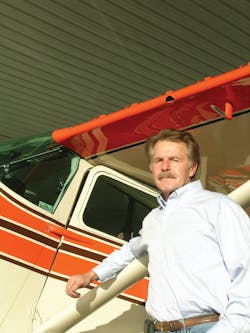ROCKFORD, IL - Bob Moreland retired from American Airlines in 2005 after flying for the carrier for 32 years. He comments, "After retirement, I wanted a place to put my airplane; I wanted a good hangar."
Located at Chicago Rockford International (RFD), Moreland says there wasn't any hangarage at the airport apart from 'steel on steel' buildings. "I didn’t want one of those because I know how tough they are on an airplane," he remarks.
"So I talked to Bob O’Brien [airport manager], and said I’d like to build my own hangar. Bob and I worked out a new type of arrangement between aircraft owners and the airport; an arrangement unique to airports."
Owners unite
"We created the idea of getting a group of aircraft owners together ... and the owners lease land from the airport," explains Moreland. "The airport provides us with three things: utilities, a pad of concrete, and a very long-term inexpensive lease.
"Once we have that, we do the rest."
The lease length for the first hangar project is sixty years. The idea is to give the owners real estate value, adds Moreland. "Each of the owners is a member of our Airmen Inc. aircraft owners association. When an individual buys one of these hangar units, they get 60 years of lease paid up front.
"So I find these guys, then I build the building custom to each of the owner’s specifications."
Currently, Moreland has completed the development of 30 individual hangar units in three buildings with a total of 39,500 sqare feet at RFD.
Building benefits
Each hangar complex is heated using solar collectors located on the roof. "For the energy of a 100-watt light bulb, the buildings are heated and never go below 55 degrees on the coldest day in Rockford," remarks Moreland.
"We heat the floors, and the floors heat the building … like a giant radiator.
"We insolate the building very well, and we are crazy about vapor barriers, and the way we seal the structure. We can hold onto the heat we get from the sun and store it in the concrete slab."
Moreland says the idea is to maintain an 'envelope' around everything. The buildings are wood-framed and insulation is added to the sides of the walls and underneath the concrete slab.
"We have a proprietary way of making the solar/radiant heating system work," explains Moreland.
"We’ve developed this and now we can take all the controls and pumps and go to any airport and replicate the success we've had here."
According to Moreland, building costs are comparable to steel-framed hangars. The entire cost -including insurance, ground rent, maintenance, electricty, heat, and water - is some $128 per month.
"Our association of owners splits everything; we have one electric meter," adds Moreland.
"The buildings also have very efficient high-energy fluorescent lighting; we are crazy about energy usage as well."
Partnering up
From here on out, Morton Buildings will construct the Moreland-concept hangar structures.
"Until now, I was the contractor," says Moreland. "Morton heard about the buildings and sent a couple engineers here … they were interested in the feasibility of this new building concept.
"I showed them my gas and electric bills … they were negligible; we started an arrangement from there."
Says Moreland, Morton typically developes buildings for the agriculture industry, and shops for industrial applications; the company built few hangars.
"Morton hired me as a consultant to bring them in and use their building," he remarks. "The company’s Energy Performer building is easily adaptable to this concept."
The first Moreland/Morton building will be located at RFD. "If another airport wants this, I tell them what’s required and we do the advertising and get the customers," says Moreland.
"That will be my role going forward – to carry this idea across the country and to find customers who are interested in this type of storage solution."
For more information about the Moreland/Morton hangar solution, visit www.morelandenterprises.com.

